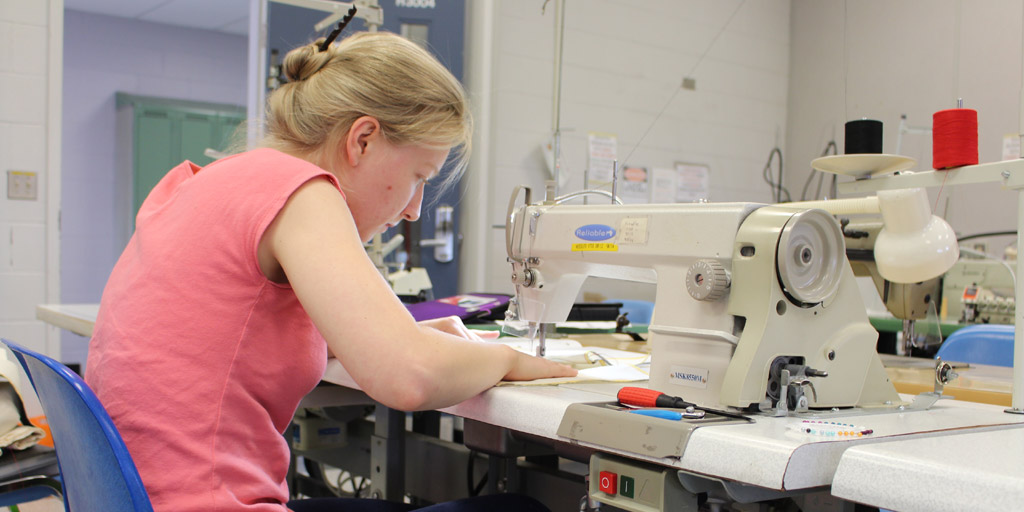Fanshawe's fashion program teaches sustainability to a new generation
 CREDIT: ANGELA MCINNES
CREDIT: ANGELA MCINNESStudents in Fanshawe's fashion design program are taught from the get-go to design for sustainability.
The earth is warming up, and the clothes you’re wearing are part of the reason. The fashion industry is the second biggest contributor to pollution next to oil, according to greenmatch.co.uk. Moreover, the dye used to make the fabrics contaminate and pollute water, according to Jennifer Wright, a professor of fashion design in Fanshawe’s Faculty of Creative Industries.
Fast fashion may be cheap, but cheap quality destroys the earth. Low-quality fabrics are made out of materials like polyester and mixed fibers that take 200 years to decompose. Wright explained that buying clothes made out of 100 per cent cotton are better, as cotton decomposes in only two years. However, she recommended that consumers change their buying practices, as cotton may be a better option, but uses a high amount of water to make.
“One cotton T-shirt takes what you drink per day over three years to produce,” Wright said.
So instead of buying ten cotton T-shirts, buy one. Think about what you need and not what you want.
“Consumers need a movement back to buying less and buying higher quality,” She added.
Your wardrobe may be smaller, but at least you know that the earth is thanking you for it.
Taking a closer look at students in Fanshawe’s School of Design, Wright shared what the school is doing to promote and contribute to fashion sustainability.
Throughout the three-year fashion design program, each year, students partake in a fashion sustainability project. First-years are required to design and produce a skirt made from materials that can be found at distribution centres after products were not sold in thrift shops, like Goodwill. Students deconstruct the fabrics that collected from the distribution centres and then reconstruct them to produce a skirt.
Second-years have a similar objective, however they make a coat out of 100 per cent waste materials that are found in the pound in the distribution centres. By their third year, students are familiar with waste materials and garments that can be used to make full sustainable outfits.
This year’s Unbound Fashion Show event will showcase the thirdyear students’ sustainable clothing made from waste, recycled materials, and other fabrics and fibers that would have been disposed of. The event takes place April 18, 2020, so come see for yourself how good you can look recycled!
How are Fanshawe fashion students driven to make pieces that are completely made out of waste materials? Professor Wright explained that the teaching process, offered at the Fanshawe fashion design program, guides students to see the donation process from start to finish.
First, sustainability and its importance on how it impacts the planet is discussed in the classroom setting, then students are guided on a physical tour of how the donation stream plays out. Thrift shops, like Goodwill, all have receiving centres where people sort through received clothes and price them.
After clothes are released on the floors, if they have not been sold in three weeks, they are consolidated at a distribution center. The students observe how these clothes then get sorted into rolling bins that are then wheeled out into balers. A baler is essentially a machine that the clothes are fed into and make cubes of clothes that weigh about 100 kilograms.
“These bales of clothing are then sent out to other countries like Africa, the Philippines, and Vietnam, to be resold. We got some evidence of bales going to Syria, and into some of the refugee camps to be resold,” Wright said.
At the end of this process, the students see walls lined with bales from floor to ceiling. Professor Wright said that talking about and then actually seeing this process helps the fashion design students get an idea of all the waste that the fashion industry causes. The abundance of materials is so overwhelming that the developing countries that these bales of clothes go to are drowning in discarded clothing.
Fanshawe, it’s time to smart shop to cool down the only planet we’ll ever call home. Professor Wright shared some tips to keep the Fanshawe community aware of buying apparel, and more importantly, donating instead of tossing clothes for waste.
For example, did you know that 25 per cent of clothes brought into donation centres, like Goodwill, go directly to waste or rags because they’re not washed? A widely believed myth about second-hand clothing centres is that they wash the clothes that are ready to be purchased. With the huge amount of intake these stores receive, it would be impossible to launder all the clothes.
Unwashed clothes never see the floors of donation centres, so wash before you donate. Do you have undergarments that you don’t wear anymore or single socks that never found their lost pair? Bring them too!
“Goodwill Industries, Salvation Army, Value Village, they have other strategies to divert from landfill. That is one of the primary things that they do, is divert from landfill,” said Wright.
These materials are not sold, but instead sent to reclaimed fibers or rags to be used for different things. Lastly, take a minute and make yourself aware of what you wear. Even if it is simply Googling ‘the impact of fast fashion’, as Professor Wright suggests, or taking it to the next step by visiting a thrift shop in the community to see how it’s all done, put some time now so we can still have time in the future.















